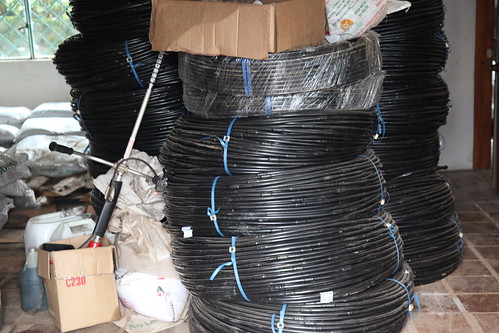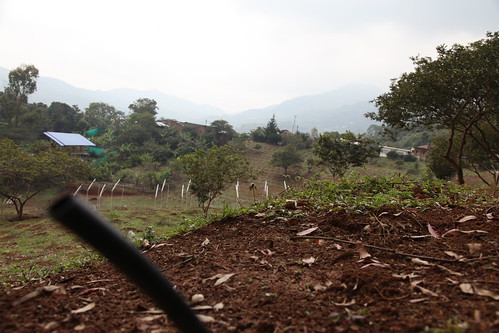Today I saw the future and it was made of black rubber tube, a metal frame and plastic sheeting. Sounds very uninspiring, but today I think I saw the future of specialty coffee farming, an option to control one of the biggest threats to coffee, let me explain.
I think there are three real threats to specialty coffee in the world at this time, let me go through them.
1. Commodity speculators
Coffee is something that’s traded in many different ways. The commodity market is the one place where the vast majority of coffee gets bought. Normally this has little to nothing to do with the way we buy coffee, but because of the recent financial issues (economic downturn, stocks and shares being less secure, banks in trouble / low interest rates) this has seen the “commodity price” wander into our playground. I think this issue will be resolved with a little bit of time and the whole world economy improving, we have seen the price drop from its high of $3.05per lb down to $2.60 per lb in the space of a few weeks – a price that I think is far more sustainable for the longer term.
2. World Demand, new world supply
World demand for coffee has been steadily growing for a number of years, while coffee availablity has been fairly consistent. This was because of an over supply of coffee into the market, but this has now been rebalanced. New consuming nations (places like Brazil, India and China all drinking more coffee than they ever have done in the past) means that demand has been growing, but because of the low coffee price the land owner has been less likely to invest in coffee as a product to grow because of lower margins.
This will change with the commodity price of coffee much higher (and I do believe higher prices than the awful sub $1.00 a lb prices of the late 90’s early 00’s will mean that lots more people will plant coffee than they have in the past. The optimist in me thinks that this new chance to plant new coffee may mean that the plant varietal stock they choose may mean that coffee in general improves, but the realist in me thinks it will be yield-led.
I also think that sustained higher prices will quell some of this growing demand, as the cost of a cup of coffee will rise – this is something you can be very sure of.
Either way more coffee will mean that demand can be met for these new consuming nations or higher prices will control the demand and that price will be more balanced in the long term. Another issue fixed and addressed (I reckon).
3. Climate Change
This is a problem that’s a lot harder to sort than the above. It matters not if you agree or disagree with why the world is getting warmer, we live on a planet that is changing and the climate is not the same as it was 10 -20 -30 years ago. Harvest times and yields of farms we have bought from for only a few years have gone through huge changes; we see some places getting hotter, some places having more rain. But one thing that’s consistent is inconsistent weather patterns.
Colombia has suffered more than most. The weather here has become so unpredictable, along with a lot of pest / disease in plants, it’s meant that growing great coffee has become harder.
Carmilo from Santurio is working on a new project just outside Cali that is firmly trying to address this. It’s working with irrigation systems to water and to feed nutrients to coffee plants directly through irrigation pipes. Using feed and nutrients through the spraying method means that coffee plants receive around 10% of the feed you put down. Feeding coffee plants through the tube means that 90% of it makes it into the plants. So less nutrients are needed so money is saved. Also by doing it this way it means that the coffee will be ready to produce its first harvest in 2 years rather than the traditional 4 years, so money is again saved. Of course there is an investment in the irrigation technology, but an investment now means it should be repaid fairly quickly.
All this is nothing new; irrigation has been used in many farms successfully, but the killer app is that all this will be done in a greenhouse type building. OK not all: they have three sections to the farm, one part un-irrigated, a test sample of doing nothing if you like, one part un greenhoused but irrigated on a program to suit, as and when needed. And the third is irrigated and in the green house. It’s going to be around 0.3 hector with approximately 1800 plants that produce 3000lb of coffee.

Green House
The reason to put it in a greenhouse is to control the environment. If it gets too hot then you water and open up the sides, if it gets too cold you drop the sides and use the solar energy to heat the greenhouse. Not enough rain – turn on the water. Need to add feed – turn on the nutrients.
I think it’s an exciting and interesting experiment to see if the environment has an impact on the final cup, having the test sample and the irrigated sample makes it twice as interesting.

Carmilo
As you can see by the photos, there are no coffee plants in yet, but this is happening in the next 20 days, so in two years’ time we will see if this works or not.
I’ve seen the future and it’s made of rubber tube.

Rubber Tube




I’ve eaten vegetables grown in greenhouses on chemical feed only. Delicious isn’t a word that springs to mind.
Which grapes taste best? The ones grown on hillsides or the ones grown in greenhouses?
Sadly I think that you are correct. You have seen the future and it’s made of rubber tube. Anything which increases yield and reduces the time to first crop will be attractive. There won’t be the same sort of need to grow on pesky hillsides in inaccessible areas either. If you control the climate, you can grow anywhere.
Speciality coffee providers (all the way through the supply chain) will have to work very hard to avoid being overwhelmed.
The soil and the water are still the same so it makes sense to use greenhouses to add protection/improve growing conditions.
Certainly an interesting experiment.
If they use it just to keep stable conditions, then I see it as a plus.
If they start using it to force the coffee plants to grow, then I can see serious quality problems ahead.
Having the 3 areas will certainly be an interesting tasting session. Is the sheeting they will be using clear or opaque? Even that could make a difference, direct sunlight vs diffused.
What would be really interesting would be to have the same varietal (hell, even the same genetic stock) planted both traditionally and in the greenhouse and then blind taste the difference.
Even if the quality isn’t as good then there’s still possibilities for the system.
It could maybe work in tandem with traditional growing, like in this experiment, where you have one area greenhoused and irrigated and one not. That way if there’s bad weather and the traditional crop fails, the farmer has the greenhoused crop to fall back on. So at least he’ll be getting some income even if its not at as higher price as the traditional crop would fetch.